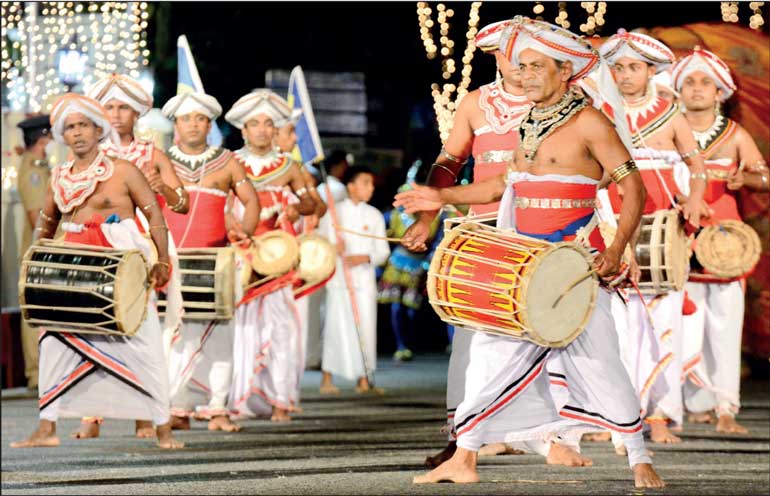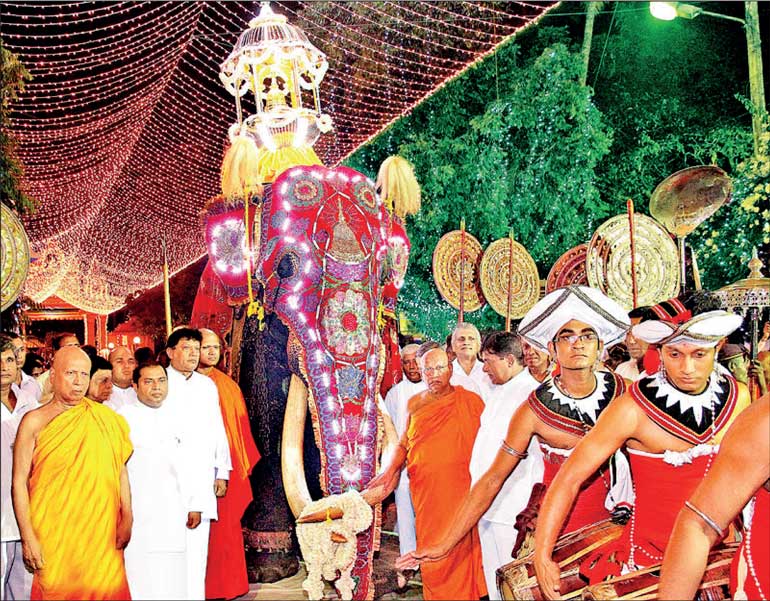Thursday Jan 08, 2026
Thursday Jan 08, 2026
Saturday, 19 August 2023 00:10 - - {{hitsCtrl.values.hits}}



In this consumerist society, it is no secret that people have to deal with life’s challenges on a regular basis. A temple is a place that gives such people the much needed relief. The Bellanvila Rajamaha Viharaya is one such place which over the years has given the people the confidence to face life’s challenges through spiritual uplift. The Bellanwila temple provides many services to the community throughout the year. Perhaps only a few Sri Lankans are aware that the Bellanwila Raja Maha Viharaya has been at the forefront of launching many diverse welfare projects.
By Sisira Wijesinghe
The legendary ‹Esala› phenomenon in the Buddhist calendar occupies a prominent place among Buddhists all over the world. A multitude of religious offerings in Buddhist faith continue to dominate Sri Lanka, giving pride of place to the Full Moon Poya day in the months of ‘Duruthu’, ‘Nawam’, ‘Vesak’, ‘Poson’, ‘Esala’, ‘Nikini’, ‘Vap’, ‘Unduwap’ etc. Of them, the month of Esala is of special significance to Buddhists for generations since the royal spectacle in the up-country, the ‘Sri Dalada Perahera’ (pageant) which fascinates people in all walks of life and is revered by thousands who converge on the streets of the hill capital. The historic annual Bellanwila Esala Perahera (pageant), the 73rd in the series began in late July after the performance of merit-transfer to all its predecessors, the architect of the pageant, the late Ven Bellanwila Sri Somaratana Nayake Thera, former incumbent of Bellanwila Raja Maha Viharaya and the late Ven (Prof) Bellanwila Wimalaratana Thera, famed for his moderate articulation against social, national, cultural and religious issues.
The pageant, begun as a ceremony to bless the affected villagers and their cattle during times of famine and an epidemic in the Bellanwila hamlet in the year 1950, has gradually grown into a mammoth religious and cultural festival. This year, the 73rd Esala festival has been offered state patronage on a directive of President Ranil Wickremesinghe through the coordination of the Chief of Presidential Staff and Senior Advisor to the President on National Security, Sagala Ratnayake.
This majestic street pageant has come a long way, thanks to the guidance of Ven. Dr. Bellanwila Dhammaratana Nayake Thero, Chief Incumbent, Bellanwila Raja Maha Viharaya and Chief Sanghanayaka of Singapore, supported by the Vihardhikari, Dr Boralesgamuwe Pemaratana Thero, Upa Viharadhikari, Ven Bellanwila Sangharatana Thero, together with members of the Esala Perahera Committee, Dayaka Sabha and a host of donors and laymen across the country. It is also noteworthy to mention the memories of the late Ven (Prof) Bellanwila Wimalaratana Anu Nayake Thero who toiled tirelessly to elevate the standards of the pageant and the affairs at the temple until his tragic demise in 2018.
Inauguration
The annual ‹Punyothsawaya›, held parallel with the island›s most leading Esala festivals in Kandy, Kataragama, Dondra, etc begins with a preaching and an alms-giving at one of the most remote areas in the country where monks and the underprivileged are donated relief packs and a variety of essentials, including school accessories. This practice began after the demise of the architect of the contemporary revivalist, Ven Bellanwila Somaratana Nayake Thero in the year 1984, through which merits are transferred. This year›s pilgrimage occurred in Puliyankulama with the participation of more than 100 monks, from distant temples and monasteries. This program follows the conduct of three consecutive preaching sessions at the Bellanwila temple compound before the customary week-long ‹Pirith› chanting commences. It is followed by the Devadootha Perahera, Dorakada Asna, Kumbal Perahera, Mal Perahera, Paawada Perahera, Ransivili Perahera and the spectacular climax, Randoli Maha Perahera on 19 August this year. Diya Kapana Perehera and Deva Daanaya including several rites and rituals bring the festival to its culmination.
Bellanwila Temple
While the late Somaratana Thera has been considered the pioneer of the modern revival, it was none other than Ven Dhammaratana Thera and the late Wimalaratana Thera who carried the name of Bellanwila to international fame and left a niche for it in overseas chronicles.
In this consumerist society, it is no secret that people have to deal with life’s challenges on a regular basis. A temple is a place that gives such people the much needed relief. The Bellanvila Rajamaha Viharaya is one such place which over the years has given the people the confidence to face life’s challenges through spiritual uplift.
The Bellanwila temple provides many services to the community throughout the year. Perhaps only a few Sri Lankans are aware that the Bellanwila Raja Maha Viharaya has been at the forefront of launching many diverse welfare projects. A symbolic charge of Rs 20 on each vehicle parked in its yard has rescued the lives of many patients. Similarly, the Community Development Centre at Bellanwila, managed by the temple with the Vocational Training Authority, provides vocational training to school dropouts. It was one of the pioneering institutes in the country even before state patronage for this came into effect.
Colourful pageants with regalia at Bellanwila in succession, hundreds of dancers, caparisoned tuskers and decorated floats during this season are a common spectacle to the villagers of Bellanwila during this fortnight. Also, hundreds of villagers from all walks of life from neighbouring Divulpitiya, Rattanapitiya, Boralesgamuwa, Pepiliyana, Nedimala, Nikape and Attidiya, most of them associated with the temple for generations, unfailingly bring alms and all essentials to the temple in procession every day during this time and express their solidarity and devotion as neighbouring villagers. Amazingly, it has unified people of all faiths in the area, irrespective of any ethnic or religious differences.
It is also pertinent to mention that Ven. Dhammaratana Nayake Thera in his capacity as the religious advisor at the Buddhist Library in Singapore always provides much-needed raw material to such multifaceted projects. Likewise, the conduct of Sunday School, Elders’ Day Care Centre, Pilgrims’ Rest and welfare shops are all patronised by the temple.
Seasonal commemoration
This is a seasonal commemoration that paves the way for both Buddhists and Hindus alike, to recall the spiritual significance attached to multiple forms of veneration, pageants (Perahera) and Poojas (offerings) in Sri Lanka. Several milestone events in the Buddhist calendar, such as the great renunciation of Prince Siddhartha in search of the eternal bliss of truth, the conduct of the Buddha’s first ‹Dhammachakka Pavatta Sutta› discourse, the conceiving of Prince Siddhartha by Queen Mahamaya Devi, the performance of twin miracles (Yamaka Maha Pratiharya), ‹Abhidhamma› preaching to the Gods in ‹Thawthisa› heaven, ordination of the first Sri Lankan into monkhood at Anuradhapura, the foundation-laying for Ruwanweli Seya and its enshrinement of relics, the great revival of Theravada Buddhist reformation at Malwathu Viharaya necessitate them to recall those sacred memories with devotion and veneration during this ‹Esala› period.
Moreover, the Esala Full Moon Poya assumes significance since it is the onset of the rainy retreat of monks, popularly called the ‘Vas’ season held across the country on a grand scale. It is owing to this combination of landmark commemorative events that the Buddhists are used to fittingly observe this day ceremonially, holding the ‘Perahera’, while giving pride of place to the historic Sri Dalada Perahera in Kandy.
Unity among all villagers
Colourful pageants with regalia at Bellanwila in succession, hundreds of dancers, caparisoned tuskers and decorated floats during this season are a common spectacle to the villagers of Bellanwila during this fortnight. Also, hundreds of villagers from all walks of life from neighbouring Divulpitiya, Rattanapitiya, Boralesgamuwa, Pepiliyana, Nedimala, Nikape and Attidiya, most of them associated with the temple for generations, unfailingly bring alms and all essentials to the temple in procession every day during this time and express their solidarity and devotion as neighbouring villagers. Amazingly, it has unified people of all faiths in the area, irrespective of any ethnic or religious differences.
The Bellanwila Esala festival began in earnest in the year 1950 as a form of offering to the Buddha and deities in response to an unfortunate cattle epidemic that pervaded the Bellanwila village and its suburbs, claiming the lives of hundreds of farming cattle and driving innocent farming communities and villagers into desperate straits of economic hardship. The late Ven Bellanwila Sri Somarathana Nayake Thero, the incumbent at Bellanwila Raja Maha Viharaya at that time, was very much disturbed over this and summoned all victims to the temple where a sacred sapling of the Jaya Sri Maha Bodhiya remains planted.
Pageants as offerings
This far-sighted incumbent monk conducted minor processions for three days around the temple and made special offerings to the Bodhiya pleading for an immediate end to this tragedy and urging God Vishnu to bless the area and for the eradication of the epidemic. Surprisingly, history records that his offerings with the villagers worked well and the situation dramatically improved. That was the initial onset of the Esala Perahara festival at Bellanwila which has now grown into a mammoth Esala spectacle. The late Ven Somarathana Nayake Thero with humble beginnings developed the temple premises to what it is today and continued this Esala pageant up until his demise in the year 1984.
The festival began with the planting of the symbolic Kap on Wednesday (Aug 9) and the conduct of Dorakada Ashna Anushasana and the Deva Dutha Perahera which again invoked blessings of the Triple Gem on all Sri Lankans, on Saturday (12). Four Mal Peraheras (pageants of flowers) that paraded inside the temple premises for four consecutive days (13 - 16 Aug) symbolise the offerings to the Buddha before the remainder of the pageants paraded the area. This year, the Pavada Perahera regarded as one of the most sacred, in which the relic casket of the Buddha and replicas of deities are taken on heads atop ‘Paavada’ (white clothes) spread along its way was on Thursday (17) amid a huge gathering of devotees. The ‘Ransivili Perahera’ that parades around the Bellanwila village, reminding the villagers of ancient practices was on Friday (18) with many dancing troupes and elephants. The climax of the festival, Randoli Maha Perahera, the final highlight with hundreds of dancers, drawn from many corners of the country is scheduled to parade along the Dehiwala - Maharagama road (Prof Bellanwila Wimalarathana Mawatha), Bellanthara - Pepiliyana road and Vihara Mawatha today ( 19) before it wends its way back to the temple premises.
The final Randoli Maha Perahera, comprising many caparisoned elephants and dancing groups is indeed one of the most spectacular and colourful pageants in the country. President Ranil Wickremesinghe has been invited to inaugurate the commencement of the final night. The event is lavishly supported by resident monks, Ven Dr Boralesgamuwe Pemarathana Thero, Ven Udugampola Hemarathana Thero, Ven Bellanwila Sangharahtana Thero, the Esala Perahera committee, Dayaka Sabha, Kulangana Samithiya, Buddhist Youth organisation, Community Development Foundation, Tharuna Sansadaya, island-wide Buddhists, donors and many other laymen of different faiths.
The Bellanwila Esala festival culminates on Sunday (20) with the ancient water-cutting ritual and the Deva Daana (alms) offered both at Boralesgamuwa and Bellanwila temple premises before the final ‹Shanthikarma› ritual invokes blessings on everyone. The Deva Daana offered to thousands by the Boralesgamuwa ‹Pararthasadaka Awamangalyadara› Association and Boralesgamuwa villagers at the water-cutting location brings the festival to an end.